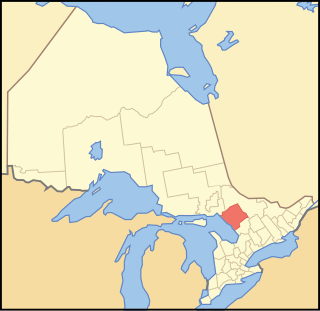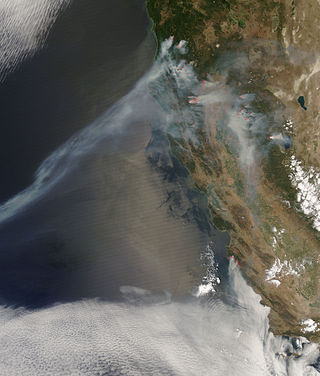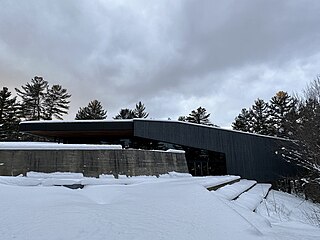
Parry Sound District is a census division of the Canadian province of Ontario. Its boundaries are District of Muskoka to the south, the Sudbury District to the north-northwest, the French River and Lake Nipissing in the north, Nipissing District and North Bay in the north and east and parts of Algonquin Park in the northeast.

The Northern Development, Mines, Natural Resources and Forestry is a government ministry of the Canadian province of Ontario that is responsible for Ontario's provincial parks, forests, fisheries, wildlife, mineral aggregates and the Crown lands and waters that make up 87 per cent of the province. Its offices are divided into Northwestern, Northeastern and Southern Ontario regions with the main headquarters in Peterborough, Ontario. The current minister is Greg Rickford.
Ontario Parks is a branch of the Ministry of the Environment, Conservation and Parks in Ontario, Canada, that protects significant natural and cultural resources in a system of parks and protected areas that is sustainable and provides opportunities for inspiration, enjoyment and education. The Ontario Parks system covers over 78,000 square kilometres (30,000 sq mi), which is about 10 per cent of the province's surface area or the equivalent of an area approximately equal to Nova Scotia. It falls under the responsibility and mandate of the province's Ministry of the Environment, Conservation and Parks. It was formerly under the mandate of the Ministry of Natural Resources and Forestry.

The Sleeper Lake Fire was a wildfire that occurred north of the Village of Newberry in Luce County, Michigan. The fire most likely started with a lightning strike on August 2, 2007 near Sleeper Lake.

The 2008 California wildfire season was one of the most devastating in the state of the 21st century. While 6,255 fires occurred, about two-thirds as many as in 2007, the total area burned— 1,593,690 acres —far exceeded that of previous years.

Woodland Caribou Provincial Park is a provincial park in Northwestern Ontario, Canada, west of the municipality of Red Lake. It borders Atikaki Provincial Park and Nopiming Provincial Park in eastern Manitoba, and is made up of Canadian Shield and boreal forest. Woodland Caribou Provincial Park is a wilderness park of 450,000 hectares, and it became part of the Pimachiowin Aki UNESCO World Heritage Site in 2018.

Centennial Lake is a reservoir lake in the Township of Greater Madawaska, Renfrew County, and the Township of North Frontenac, Frontenac County, in Eastern Ontario, Canada. It is on the Madawaska River and is part of the Saint Lawrence River drainage basin.

Henvey Inlet 2 is a First Nations reserve in Parry Sound District, Ontario, on the northeastern shore of Georgian Bay. It is one of two reserves of the Henvey Inlet First Nation.

The 2015 wildfire season was the largest in Washington state history, with more than one million acres burning across the state from June to September. As many as 3,000 firefighters including 800 Washington National Guard members were deployed to fight the fires. The 17th Field Artillery Brigade of the United States Army also deployed 200 soldiers from Joint Base Lewis–McChord to help fight the fires.

2015 Canadian wildfires were a series of wildfires across Canada and Alaska in July 2015 which spread smoke across most of North America. Over two hundred fires were ablaze across British Columbia, Saskatchewan, and Alberta.

The Barry Point Fire was a wildfire that burned over 92,977 acres (376.26 km2) of Oregon and California forest land during the summer of 2012. The fire began on 5 August 2012, the result of a lightning strike. The fire consumed public forest and rangeland as well as private forest and grazing land located in Lake County, Oregon and Modoc County, California. The public lands affected by the fire are administered by the United States Forest Service and the Oregon Department of Forestry. The largest part of the private land was owned by the Collins Timber Company. At the peak of the firefighting effort, there were 1,423 personnel working on the fire. It took 22 days to fully contain the fire and then an additional three weeks to mop it up.

On May 1, 2016, a wildfire began southwest of Fort McMurray, Alberta, Canada. On May 3, it swept through the community, forcing the largest wildfire evacuation in Alberta's history, with upwards of 88,000 people forced from their homes. Firefighters were assisted by personnel from both the Canadian Armed Forces and Royal Canadian Mounted Police, as well as other Canadian provincial agencies, to fight the wildfire. Aid for evacuees was provided by various governments and via donations through the Canadian Red Cross and other local and national charitable organizations.

The 2018 Washington wildfire season officially began June 1, 2018. A statewide state of emergency was declared by Governor Jay Inslee on July 31.

By the end of June 2018, there had been more than 560 wildfires in British Columbia.

The 2019 Alberta wildfires have been described by NASA as part of an extreme fire season in the province. In 2019 there were a total of 803,393.32 hectares, which is over 3.5 times more land area burned than in the five-year average burned. The five year average is 747 fires destroying 146,360.08 hectares. There were 644 wildfires recorded in Alberta. By May 31, 10,000 people had been evacuated, 16 homes, and the Steen River CN railway bridge, had been destroyed.

The Key River is a short river in Central Ontario, Canada. It flows 16 kilometres (9.9 mi) from Portage Lake west to its mouth at Key Harbour in Georgian Bay of Lake Huron. The river allows access to Northeastern Georgian Bay for recreational anglers, cottagers, and canoeists from Ontario Highway 69. The river is mostly bound by the French River Provincial Park on its northern shore, and by Henvey Inlet First Nation Reserve on its southern shore.

Beginning in March 2023, and with increased intensity starting in June, Canada was affected by a record-setting series of wildfires. All 13 provinces and territories were affected, with large fires in Alberta, British Columbia, the Northwest Territories, Nova Scotia, Ontario, and Quebec. The 2023 wildfire season had the most area burned in Canada's recorded history, surpassing the 1989, 1995, and 2014 fire seasons, as well as in recorded North American history, surpassing the 2020 Western US wildfire season.

The French River Provincial Park Visitor Centre is an information, education, and events centre along the French River in Ontario, Canada. The building opened in 2006 and was designed by Baird Sampson Neuert Architects in collaboration with the Government of Ontario, Ministry of Natural Resources. The building serves as a educational and recreational hub for tourists and the surrounding communities.

















